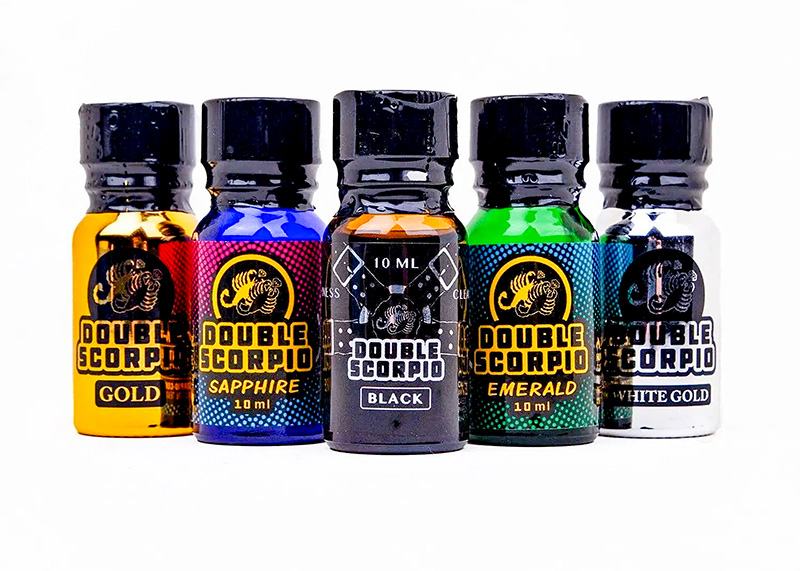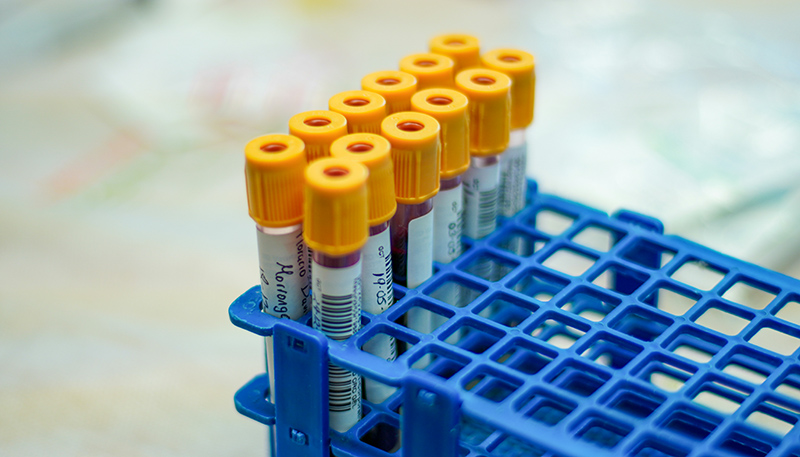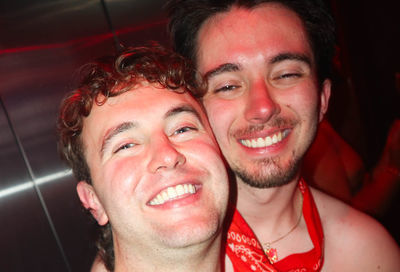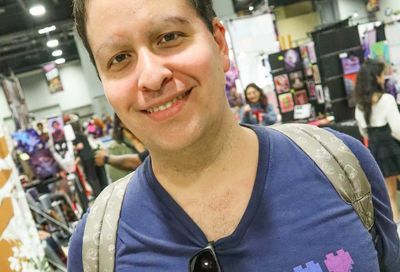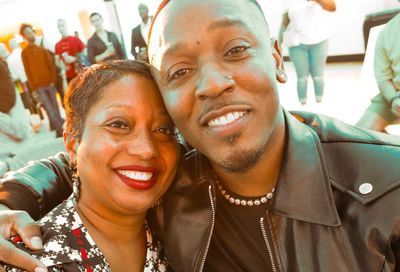Adam Tenner
Metro TeenAIDS
Headquartered in a basement along Pennsylvania Avenue SE, nearly spitting distance from the Capitol, the drop-in center and offices of Metro TeenAIDS (MTA) are very unassuming. The art on the walls is created by clients, using mixed media of personal photos, condoms, glue and motivational messages. The furniture is mismatched, threadbare in spots, yet comfortable. During a rainy, midweek lunch hour, the mood is upbeat. HIV may kill people, but it hasn’t managed to kill youthful enthusiasm.
Initially launched in 1988 as the Washington Area Consortium on HIV Infection in Youth, MTA has been battling HIV/AIDS in D.C.’s youth community for 17 years. Today, estimates point to 2,500 to 3,500 HIV-positive young people in the D.C. metro area, according to MTA. Further, possibly a third of those are unaware of their status.
While the lines of communication from adults to young people are often muddled, when it comes to HIV, communication with youth is literally a matter of life and death.
 Tenner |
Though recent cuts in federal funding from the Centers for Disease Control and Prevention (CDC) forced MTA to dismiss three outreach employees, the organization soldiers on, offering a drop-in center, peer education and HIV testing.
Adam Tenner, MTA’s executive director, took time out to talk about HIV in D.C. as it relates to the 13-to-24-year-old community they serve.
METRO WEEKLY: Do the programs at Metro TeenAIDS delve much into issues dealing with men who have sex with men (MSM)? It seems you walk a delicate line between trying to disseminate information and not alienating young males who may have sex with other males, but eschew a ”gay” identity.
ADAM TENNER: It is a delicate balance. We actually serve a really high number of heterosexual African-American men as well. And heterosexual African-American young women. We try to make sure that our language is always very neutral, because we don’t always know what people’s behavior is unless they tell us.
We’re always trying to be mindful of how to improve our services for young MSM. At the moment, we probably do a better job reaching the non-gay identified than the gay-identified young people.
MW: Do you see large numbers of transgender youth?
TENNER: No, but we’ve helped to put on some citywide transgender youth events, like Transgender Boot Camp. That brought together about 90 transgender young folks to talk about their issues [and] HIV-prevention issues. We did that in coalition with a lot of other organizations.
We’ll partner with the Latin American Youth Center, Concerned Black Men, Sexual Minority Youth Assistance League, Children’s National Medical Center. It’s a really wide range.
MW: Who are your typical clients?
TENNER: Most of our kids come from the lowest third of the incomes in the city. HIV-infected youth tend to be some of the most disenfranchised. The kids who come to this center tend to be mostly from Potomac Gardens and other places in the neighborhood, or Anacostia. But our school programs hit a much wider swath of young people.
We primarily focus on the district. When I got here four years ago, we had programs in Maryland and Virginia that weren’t doing very well. So we decided to focus here in the district because there is such a huge epidemic, and we want to make sure that district youth are being served.
We have an eye to Prince George’s County, which, for youth in general, has very few services. I think what we’ll see in the next few years is the epidemic moving to P.G. County as more folks move out to the suburbs.
MW: Are the majority of youth that use the MTA drop-in center HIV-positive?
TENNER: It’s a mix.
MW: As the executive director of MTA, what do you see when you look at the district?
TENNER: Oy. Getting to services in the District of Columbia is like getting around in the District of Columbia. You can start on a grid, but find out that U Street ends — and starts again somewhere else. Or that a one-block street exists that doesn’t pick up anywhere else. You’re constantly hitting circles and angled streets, and it takes a long time to realize that a seemingly indirect path might be the shortest, most effective path. It may be the only path to go where you want to go. I think it’s a very difficult system to navigate.
That said, I feel very hopeful right now about lots of changes that are happening with the schools under the leadership of the new superintendent of the school board. They were able to pass a number or resolutions to try to improve HIV prevention and education, HIV services to D.C. public-school youth.
MW: The ”system” you’re talking about, do you mean for a youth who is positive and trying to access services? Or for someone seeking HIV-prevention information? Or of bureaucracies at the city or federal level?
TENNER: I think that our city systems fail young people, and have consistently been failing young people in a number of ways. We do have some wonderful services, but in the capital of the richest country in the world, the fact that we have the highest HIV rate in the country is shameful and disheartening. We have young people not necessarily understanding that they’re really at risk for HIV. We have young people who don’t seem to even know the basic facts about HIV. We have young people who don’t believe their lives are worthy of avoiding HIV. They believe they’re going to get shot walking down the street to 7-11. That’s a far greater, more real risk to them than a disease that might get them sick 10 years down the road.
And a level of stigma exists that young people end up getting disconnected from their families. In general, young people tend to not like to go to the doctor. Young people who are sexually active, studies show, are even less likely [to visit a doctor] because they fear having to pay for something, or having to tell the doctor something that might get back to their family.
These are the sorts of barriers that are set up that are systemic and cultural for young people not getting what they need. You have to give people not just the information, but you have to give them the skills they need to protect themselves from HIV. You have to work with them on believing that their lives are worth not getting HIV. We actually spend a lot of time and programming talking to people about, ”What do you want to be doing? Where is your life going?”
In our city, we have a lot of young people that we work with who graduate from high school with no direction, no plan for the future, and no adult pushing them toward what they want to do. Those kids grow up into adults.
MW: Talk a little bit about some of the young people you work with.
TENNER: We had one very young guy at our drop-in center. His only goal was to be the first person in his family to graduate from high school without getting arrested or getting someone pregnant.
Recently, we did a go-go event. We had over 200 kids come. A hundred-plus got tested [for HIV]. We tested a young, 15-year-old African-American girl who tested positive. She had no idea that she was going to test positive. She was completely blindsided. She’s getting connected to medical care now.
We have a whole program that exists to work with young people who are newly infected. It’s a very time-sensitive process. The early stages are really crucial. The conversation about HIV isn’t the first conversation. The first conversation is about building trust. It’s about processing what’s going on with them, in terms of processing grief and loss in terms of HIV. Ultimately, it’s about helping them get to their appointments and being able to advocate for themselves in the system and getting — and staying connected — to care.
Most of the kids who test positive are some of the most disenfranchised kids in the city. They’re unstably housed, with non-supportive families. They’re outcast from churches. Whatever their social support systems are, they’re usually outside of them. For them, HIV is not even the most important issue in their lives.
MW: Despite having the job you have, which would depress a lot of people, you seem to be remarkably optimistic.
TENNER: One of the joys of working in Washington, D.C., is that every little change that you can makes seems like a huge triumph. Though that’s a somewhat sad statement to make.
MW: But you say it with a smile.
TENNER: I do, and I mean it. We take our young people down to the City Council and they testify, and it means something. Last week, I met with the Health Department and the schools and talked to City Council members, and I could feel like the possibility for change really exists. And our job as Metro TeenAIDS is to make sure that systems open up to really serve these young people. We’re committed to the fight.
We currently have 15 to 20 young people who are on staff part-time as peer educators. We have a young-women-of-color leadership council. We have groups of young people who do outreach, who are trained to communicate with their peers and get the message out. When you see them moved by these issues, really grasping what HIV is doing to their community and to our entire community, it’s much easier to come to work. They’re so hopeful.
The funding loss from the CDC was a catalyst for change at Metro TeenAIDS, in that my board went through an examination of, ”Is this what we want to be doing now?” The staff, the youth, the board and myself came back and resoundingly said, ”Yes, this is what we want to be working on.” If we’re not talking about this, nobody is going to be talking about this. We have a lot of great allies in the city, but this is not what they beat on tables about. This is what we beat on tables about.
MW: Do you have a greater interest than most in the future of HIV’s impact on the city because you work with young people? Does working with people who have so much of their lives in front of them shift focus to the future?
TENNER: I think that’s true. The HIV epidemic in Washington, D.C. — especially in wards 7 and 8 — now looks like sub-Saharan Africa. There are as many women with AIDS as there are men. This is one of the few places in the entire country where that’s true. Young women who come [to MTA] are at extremely high risk for HIV infection. That calls your attention to wondering, well, what is happening in sub-Saharan Africa? The work forces are being decimated. If you go to the World Bank, HIV is an economic development issue.
There are implications for all of us. Whether it’s our family members, our lovers, people we care about, city leaders who have to do planning — there is a good reason for anyone to get involved in HIV prevention and in providing good medical care for HIV-infected citizens of Washington, D.C.
For more info on Metro TeenAIDS and its programs, visit www.metroteenaids.org or call 202-543-9355.
Support Metro Weekly’s Journalism
These are challenging times for news organizations. And yet it’s crucial we stay active and provide vital resources and information to both our local readers and the world. So won’t you please take a moment and consider supporting Metro Weekly with a membership? For as little as $5 a month, you can help ensure Metro Weekly magazine and MetroWeekly.com remain free, viable resources as we provide the best, most diverse, culturally-resonant LGBTQ coverage in both the D.C. region and around the world. Memberships come with exclusive perks and discounts, your own personal digital delivery of each week’s magazine (and an archive), access to our Member's Lounge when it launches this fall, and exclusive members-only items like Metro Weekly Membership Mugs and Tote Bags! Check out all our membership levels here and please join us today!




